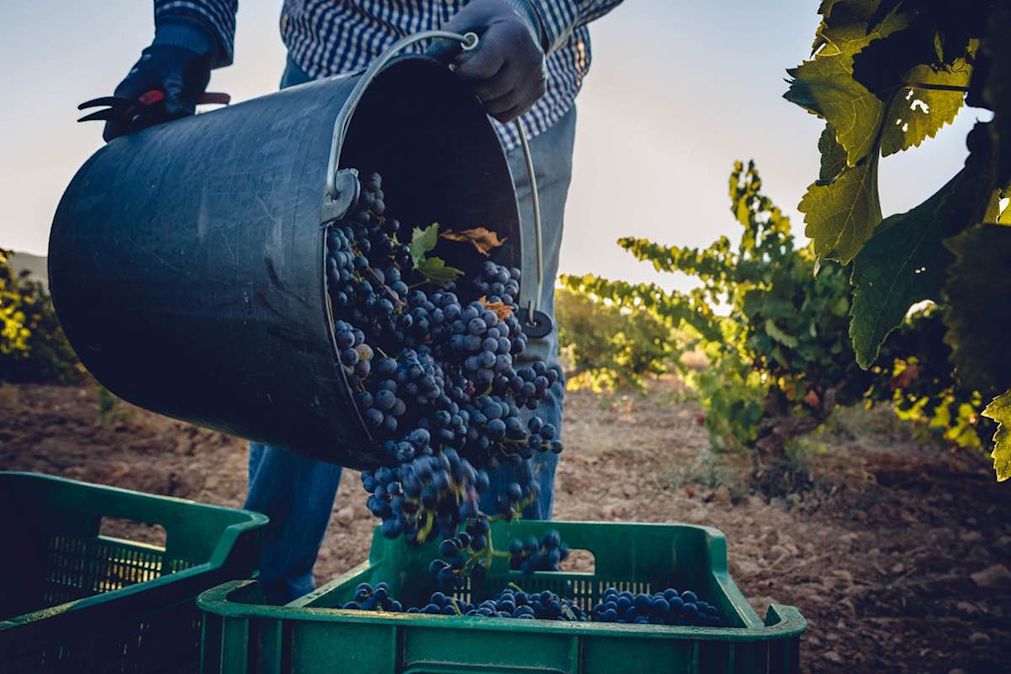Chat with Vinny
Planning a Spanish wine adventure? Discover the top five regions to explore – from Rioja’s bold reds to Rías Baixas’ zesty whites – plus the must-try wines from each.
There are few places better than Spain for wine lovers to visit. For a start, it has more vineyards than any other country in the world. So, wherever you’re staying, you’ll never be far from a wine region. It’s also incredibly welcoming to wine tourists, with some fabulous winery hotels and restaurants. And it’s extremely diverse – from the crisp whites of ‘Green Spain’ to the barrel-aged reds of sun-drenched Rioja, each Spanish wine region is distinctly different.
In fact, Spain has over 70 Denominations of Origin (check out our Guide to wine classifications around the world to find out more), so narrowing it down to just five wine regions is tricky. But these Spanish wine regions not only make some of the best wines in Spain, they’re also amazing places to visit.

In (my) order of priority … here are the top 5 Spanish wine regions to visit:
1. Jerez, Andalucía
Okay, so this might be controversial putting Jerez, the home of sherry, at the number one slot. Surely, it should be Rioja, right? Well, the thing about sherry is that it’s truly unique. From the crisp, bone-dry Manzanilla and Fino sherries (my favourites), to nutty, complex Amontillado, Palo Cortado and Oloroso, and the wonderfully rich and sweet Pedro Ximénez, these are wines you won’t find anywhere else. You can find out how these are made in our Beginner’s Guide to Sherry.
And there’s no doubt that sherry tastes best at its source, either sat overlooking the sea in one of the many great seafood restaurants of Sanlúcar de Barrameda (one of the towns in the ‘sherry triangle’) or in a buzzy tapas bar in nearby Seville.
Talking of tapas, Andalucía is where it all began (or at least that’s what they say!). So, there’s no place better to discover the delights of tapas bar hopping!
Aside from the food and wine, there are a whole host of other reasons to visit this corner of Spain. In fact, it’s impossible to fit everything in a single visit to Andalucía. From surfing in Cadiz, to flamenco dancing in Seville, or visiting the majestic sights of the Alhambra in Granada and the Mezquita in Cordóba, I guarantee you’ll want to go back.
Fly to: Jerez, Seville or Malaga
Stay in: Seville – easy train links to Cadiz, Jerez, Cordóba and Granada

2. Rioja
Think of Spanish wine regions and you think of Rioja. One of the most famous wine regions in the world, renowned for its ageworthy red wines, Rioja deserves its iconic status.
Wine has been made in Rioja for centuries, but this is not a wine region resting on its laurels. Alongside the Rioja old guard, you’ll find plenty of cutting-edge wineries making modern styles of Rioja. And it’s not until you get up close and personal with this Spanish wine region that you truly appreciate the depth and breadth of wines being produced here.
Of course, you’ll still find the long barrel-aged Reserva and Gran Reserva red wines that made us all fall in love with Rioja in the first place. But there are also plenty of crisp, refreshing whites and rosés. Not to mention all the exciting single vineyard projects and the revival of traditional Rioja varieties like Mazuelo and Graciano. There really is so much going on in Spain’s most famous wine region.
What makes this such a standout wine region of Spain (other than the obvious) is that there are some architecturally stunning wineries to visit. From Marqués de Riscal, designed by Frank Gehry, with its Michelin-starred restaurant and luxury hotel, to López de Heredia, one of Rioja’s oldest wineries, with its striking Zaha Hadid building in front of the old bodega.
And if you want to venture further afield, check out the neighbouring wine region of Navarra, where they make similar-styled red wines at a great price.
Fly to: Bilbao
Stay in: Logroño (and don’t miss out on a ‘pinchos’ crawl along Calle Laurel)

3. Rías Baixas, Galicia
If you’re looking for Spain’s best white wines, then head to the wine region of Rías Baixas, the home of Albariño. Located in northwestern Spain in Galicia, on the windswept Atlantic coast, it’s a lush, cool area known as ‘Green Spain’.
Rías Baixas shares the same mineral-rich soils and cool climate as renowned regions like France’s Loire Valley and Marlborough in New Zealand. This helps produce white wines that are crisp, elegant and zesty with fresh notes of citrus, white peach and apricot.
Made close to the Atlantic Ocean, these wines are also known for their pristine purity and mineral freshness, with a distinct sea-breeze, salty tang. Unsurprisingly, given their coastal origins, Albariño wines go brilliantly with seafood, for which Galicia is world-famous.
Rías Baixas is still a remarkably undiscovered part of Spain. And I say remarkably because there is SO much to see. Cambados is the ‘capital of Albariño’, a beautiful coastal village worth a visit at any time of year but especially during the Albariño Festival in August.
It’s also less than an hour from Santiago de Compostela, the end point of the Camino de Santiago, and a beautiful city to visit whether you’re a pilgrim or not. Then there are the beaches. Look up the Cíes Islands, just off the coast of Rías Baixas, and you’d think they were in the Caribbean!
Fly to: Santiago de Compostela or Vigo
Stay in: Cambados for the full Albariño experience

4. Penedès & Priorat, Catalonia
I’m cheating a bit here by putting these two Spanish wine regions together as the wines couldn’t be more different in style. They are both, however, possible to visit as day trips from Barcelona and make a great combo for wine lovers.
First up, Penedès – the birthplace of Spain’s sparkling wine, Cava. Cava can come from anywhere in Spain but around 90% comes from the Penedès region. The capital of Cava is Sant Sadurní d’Anoia, which is a great place to start any visit as it’s home to loads of bodegas for you to get a taste of Spain’s famous fizz. Plus, it’s just over an hour outside Barcelona and accessible by a direct train, so there’s no need to book an expensive tour to enjoy a full day of wine tasting.
The beauty of Cava is that it’s made in the ‘traditional method’ – the same way as Champagne. Yet prices are vastly cheaper, especially in Spain! The big difference lies in the grape varieties used. Cava is made mainly from local Spanish grape varieties – Parellada, Macabeo and Xarel-lo. Look forward to ripe orchard fruit flavours with floral notes and classic brioche richness.
Penedès is the easiest wine region to visit from Barcelona, but red wine fans will want to add a visit to Priorat, one of Spain’s finest red wine regions. It’s a small, fine wine region known for its powerful red wines and the only wine region, other than Rioja, to be a DOCa, Spain’s highest classification.
It is possible to reach Priorat by train direct from Barcelona (Marçà-Falset approx. 2 hours) but it’s not easy to then arrange visits to wineries close by. Many wineries require reservations to visit (not because tourists aren’t welcome but because they’re such small, family-run operations). So, while I tend to avoid recommending wine tours, Priorat is one wine region where it’s worth the extra expense.
Fly to: Barcelona
Stay in: Barcelona so you can visit both wine regions
Can we have 2 buttons?

5. Ribera del Duero, Castilla y León
Ribera del Duero is one of Spain’s top red wine-producing regions and located about halfway between Madrid and Bilbao. As the name suggests, the vineyards stretch along the Duero River, the same river that flows all the way to the city of Porto in Portugal, where it’s known as the Douro. It’s no surprise then that both the Douro and Ribera del Duero wine regions are known for their rich, concentrated red wines.
The red wines of Ribera del Duero are nearly all made from Tempranillo, often known here as Tinto Fino or Tinta del Pais. And undoubtedly the most famous wine of Ribera del Duero, and indeed Spain, is Vega Sicilia.
You can visit Ribera del Duero as a day trip from Madrid, but our advice to take your time and spend a few days in the region travelling along the 115km Ribera del Duero wine route.
Ribera del Duero is only 2 hours from Rioja, so red wine fans could easily combine the two on the same trip. Alternatively, the Spanish wine regions of Rueda (famous for its crisp, zesty white wines made from Verdejo and Sauvignon Blanc) and Toro (known for its big, juicy red wines made from the local Tinta de Toro grape) are also located on the Duero River. Or why not keep on going all the way along into Portugal and tie in with a trip to the Douro Valley? So many options!
Fly to: Madrid
Stay in: Peñafiel (a beautiful medieval town with a castle) or Aranda del Duero (the capital of Ribera del Duero)

About the author
Sarah Turner
Sarah is a wine writer and editor with over 25 years’ experience in the world of wine. She began her career in retail, passing the WSET Level 4 Diploma, before becoming a supermarket wine buyer and finally finding her home in our creative team. Her love of food, wine and travel has taken her all over the world, but she has a soft spot for Portugal’s Douro Valley and the sherries and tapas bars of Andalucia.

